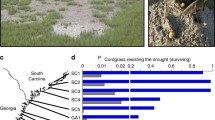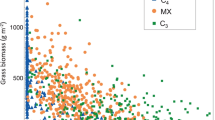Abstract
Climate change and consumer outbreaks are driving ecosystem collapse worldwide. Although much research has demonstrated that these factors can interact, how heterogeneity in top–down control intensity and physical forcing modulates ecosystem resilience to climate stress remains poorly understood. Here, we explore whether the nocturnal herbivorous crab Sesarma reticulatum can control spatially dominant cordgrass (Spartina alterniflora) growth and how its top–down effects vary with crab density, drought stress, and large-scale disturbance in southeastern US salt marshes. In multiple field experiments and surveys, we show that Sesarma depresses cordgrass growth and that its effects increase in a saturating manner with increasing crab density, such that the highest naturally occurring densities of this consumer can trigger local cordgrass die-off. This top–down effect of Sesarma is similar in magnitude to what is thought to be the dominant grazer in the system, the marsh periwinkle snail Littoraria irrorata. In a drought stress by Sesarma density experiment, we further show that salinity stress and intensive crab herbivory additively suppress cordgrass drought resistance. After drought subsides, surveys and experiments reveal that Sesarma also stifles cordgrass re-growth into existing die-off areas. Together, these results show that multiple grazers powerfully regulate the productivity and drought resilience of these intertidal grasslands and that heterogeneity in physical stress and consumer density can dictate when and where top–down forcing is important. More generally, this work provides a rare, experimental demonstration of the critical role top–down control can play across the initiation and recovery stages of ecosystem die-off.






Similar content being viewed by others
References
Alber M, Swenson E, Adamowicz S, Mendelssohn IA (2008) Salt marsh dieback: an overview of recent events in the US. Estuar Coast Shelf Sci 80:1–11. https://doi.org/10.1016/j.ecss.2008.08.009
Alberti J, Escapa M, Daleo P et al (2007) Local and geographic variation in grazing intensity by herbivorous crabs in SW Atlantic salt marshes. Mar Ecol Prog Ser 349:235–243. https://doi.org/10.3354/meps07089
Alexander SK (1979) Diet of the periwinkle Littorina irrorata in a Louisiana salt marsh. Gulf Res Rep 6:293–295. https://doi.org/10.18785/grr.0603.11
Angelini C, Silliman BR (2012) Patch size-dependent community recovery after massive disturbance. Ecology 93:101–110. https://doi.org/10.1890/11-0557.1
Angelini C, Altieri AH, Silliman BR, Bertness MD (2011) Interactions among foundation species and their consequences for community organization, biodiversity, and conservation. Bioscience 61:782–789. https://doi.org/10.1525/bio.2011.61.10.8
Angelini C, van der Heide T, Griffin JN et al (2015) Foundation species’ overlap enhances biodiversity and multifunctionality from the patch to landscape scale in southeastern United States salt marshes. Proc R Soc B Biol Sci 282:20150421. https://doi.org/10.1098/rspb.2015.0421
Angelini C, Griffin JN, van de Koppel J et al (2016) A keystone mutualism underpins resilience of a coastal ecosystem to drought. Nat Commun 7:12473. https://doi.org/10.1038/ncomms12473
Atkins RL, Griffin JN, Angelini C et al (2015) Consumer–plant interaction strength: importance of body size, density and metabolic biomass. Oikos 124:1274–1281. https://doi.org/10.1111/oik.01966
Brodie J, Fabricius K, De’ath G, Okaji K (2005) Are increased nutrient inputs responsible for more outbreaks of crown-of-thorns starfish? An appraisal of the evidence. Mar Pollut Bull 51:266–278. https://doi.org/10.1016/j.marpolbul.2004.10.035
Bruno JF, Bertness MD (2001) Habitat modification and facilitation in benthic marine communities. In: Bertness MD, Gaines S, Hay M (eds) Marine community ecology. Sinauer, Sunderland, pp 201–216
Campbell AH, Vergés A, Steinberg PD (2014) Demographic consequences of disease in a habitat-forming seaweed and impacts on interactions between natural enemies. Ecology 95:142–152. https://doi.org/10.1890/13-0213.1
Chambers RM, Odum WE (1990) Porewater oxidation, dissolved phosphate and the iron curtain—Iron–phosphorus relations in tidal freshwater marshes. Biogeochemistry 10:37–52. https://doi.org/10.1007/BF00000891
Connell JH, Hughes TP, Wallace CC (1997) A 30-year study of coral abundance, recruitment, and disturbance at several scales in space and time. Ecol Monogr 67:461–488. https://doi.org/10.1890/0012-9615
Coverdale TC, Altieri AH, Bertness MD (2012) Belowground herbivory increases vulnerability of New England salt marshes to die-off. Ecology 93:2085–2094. https://doi.org/10.1890/12-0010.1
Daiber FC (1982) Animals of the tidal marsh. Van Nostrand Reinhold, New York
Daleo P, Iribarne O (2009) Beyond competition: the stress-gradient hypothesis tested in plant–herbivore interactions. Ecology 90:2368–2374. https://doi.org/10.1890/08-2330.1
Daleo P, Silliman B, Alberti J et al (2009) Grazer facilitation of fungal infection and the control of plant growth in south-western Atlantic salt marshes. J Ecol 97:781–787. https://doi.org/10.1111/j.1365-2745.2009.01508.x
Dayton PK (1972) Toward an understanding of community resilience and the potential effects of enrichments to the benthos at McMurdo Sound, Antarctica. In: Proceedings of the colloquium on conservation problems in Antarctica. Allen Press, Lawrence, Kansas
De Fouw J, Govers LL, Van De Koppel J et al (2016) Drought, mutualism breakdown, and landscape-scale degradation of seagrass beds. Curr Biol 26:1051–1056. https://doi.org/10.1016/j.cub.2016.02.023
Delgado-Baquerizo M, Maestre FT, Gallardo A et al (2013) Decoupling of soil nutrient cycles as a function of aridity in global drylands. Nature 502:672–676. https://doi.org/10.1038/nature12670
Elmqvist T, Folke C, Nyström M et al (2003) Response diversity, ecosystem change, and resilience. Front Ecol Environ 1:488–494. https://doi.org/10.1890/1540-9295(2003)001[0488:RDECAR]2.0.CO;2
Engkvist R, Malm T, Tobiasson S (2000) Density dependent grazing effects of the isopod Idotea baltica Pallas on Fucus vesiculosus L in the Baltic sea. Aquat Ecol 34:253–260. https://doi.org/10.1023/A:1009919526259
Estes JA, Terborgh J, Brashares JS et al (2011) Trophic downgrading of planet Earth. Science 333:301–306. https://doi.org/10.1126/science.1205106
He Q, Silliman BR, Liu Z, Cui B (2017) Natural enemies govern ecosystem resilience in the face of extreme droughts. Ecol Lett 20:194–201. https://doi.org/10.1111/ele.12721
Hensel MJS, Silliman BR (2013) Consumer diversity across kingdoms supports multiple functions in a coastal ecosystem. Proc Natl Acad Sci USA 110:20621–20626. https://doi.org/10.1073/pnas.1312317110
Holdredge C, Bertness MD, Altieri AH (2009) Role of crab herbivory in die-off of New England salt marshes. Conserv Biol 23:672–679. https://doi.org/10.1111/j.1523-1739.2008.01137.x
Holling CS (1973) Resilience and stability of ecological systems. Annu Rev Ecol Syst 4:1–23. https://doi.org/10.1146/annurev.es.04.110173.000245
Hughes TP (1994) Phase shifts, catastrophes, large-scale degradation reef coral Caribbean. Science 265:1547–1551
Hughes ZJ, FitzGerald DM, Wilson CA et al (2009) Rapid headward erosion of marsh creeks in response to relative sea level rise. Geophys Res Lett 36:1–5. https://doi.org/10.1029/2008GL036000
Krumhansl KA, Lee JM, Scheibling RE (2011) Grazing damage and encrustation by an invasive bryozoan reduce the ability of kelps to withstand breakage by waves. J Exp Mar Biol Ecol 407:12–18. https://doi.org/10.1016/j.jembe.2011.06.033
Lenihan HS, Peterson CH (1998) How habitat degradation through fishery disturbance enhances impacts of hypoxia on oyster reefs. Ecol Appl 8:128–140
McKee KL, Mendelssohn IA, Materne MD (2004) Acute salt marsh dieback in the Mississippi River deltaic plain: a drought-induced phenomenon? Glob Ecol Biogeogr 13:65–73. https://doi.org/10.1111/j.1466-882X.2004.00075.x
Mendelssohn I, Morris J (1999) Ecophysiological controls on the productivity of Spartina alterniflora. In: Weinstein M, Kreeger D (eds) Concepts and controversies in tidal marsh ecology. Kluwer Academic Publishers, Boston, pp 59–80
Mitsch WJ, Gosselink JG (2001) Wetlands. Van Nostrand Reinhold, New York
Nykänen H, Koricheva J (2004) Damage-induced changes in woody plants and their effects on insect herbivore performance: a meta-analysis. Oikos 104:247–268. https://doi.org/10.1111/j.0030-1299.2004.12768.x
O’Donnell JPR, Schalles JF (2016) Examination of abiotic drivers and their influence on Spartina alterniflora biomass over a twenty-eight year period using Landsat 5 TM satellite imagery of the Central Georgia Coast. Remote Sens 8(6):477. https://doi.org/10.3390/rs8060477
Orth RJ, Moore KA (1984) Distribution and abundance of submerged aquatic vegetation in Chesapeake Bay: an historical perspective. Estuaries 7:531–540. https://doi.org/0160-8347/84/04B0531-10$01.50/0
Pandolfi J, Connolly S, Marshall D, Cohen A (2011) Projecting coral reef futures under global warming and ocean acidification. Science 333:418–422. https://doi.org/10.1126/science.1204794
Polis G (1999) Why are parts of the world green? Multiple factors control productivity and the distribution of biomass. Oikos 86:3. https://doi.org/10.2307/3546565
Scheffer M, Carpenter S, Foley JA et al (2001) Catastrophic shifts in ecosystems. Nature 413:591–596. https://doi.org/10.1038/35098000
Seavey JR, Pine WE, Frederick P et al (2011) Decadal changes in oyster reefs in the Big Bend of Florida’s Gulf Coast. Ecosphere 2:114. https://doi.org/10.1890/ES11-00205.1
Shaver EC, Shantz AA, McMinds R et al (2017) Effects of predation and nutrient enrichment on the success and microbiome of a foundational coral. Ecology 98:830–839. https://doi.org/10.1002/ecy.1709/suppinfo
Silliman BR, Bertness MD (2002) A trophic cascade regulates salt marsh primary production. Proc Natl Acad Sci USA 99:10500–10505. https://doi.org/10.1073/pnas.162366599
Silliman BR, Newell SY (2003) Fungal farming in a snail. Proc Natl Acad Sci USA 100:15643–15648. https://doi.org/10.1073/pnas.2535227100
Silliman BR, Zieman JC (2001) Top-down control of Spartina alterniflora production by periwinkle grazing in a Virginia salt marsh. Ecology 82:2830–2845. https://doi.org/10.1890/0012-9658(2001)082[2830:TDCOSA]2.0.CO;2
Silliman BR, van de Koppel J, Bertness MD et al (2005) Drought, snails, and large-scale die-off of southern US salt marshes. Science 310:1803–1806. https://doi.org/10.1126/science.1118229
Silliman BR, McCoy MW, Angelini C et al (2013) Consumer fronts, global change, and runaway collapse in ecosystems. Annu Rev Ecol Evol Syst 44:503–538. https://doi.org/10.1146/annurev-ecolsys-110512-135753
Soomdat NN, McCoy M, Hensel MJS et al (2014) Independent and combined effects of multiple predators across ontogeny of a dominant grazer. Oikos 123:1081–1090. https://doi.org/10.1111/oik.01579
Vu HD, Wieski K, Pennings SC (2017) Ecosystem engineers drive creek formation in salt marshes. Ecology 98:162–174. https://doi.org/10.1002/ecy.1628
Williams DE, Miller MW (2005) Coral disease outbreak: pattern, prevalence and transmission in Acropora cervicornis. Mar Ecol Prog Ser 301:119–128. https://doi.org/10.3354/meps301119
Zaneveld JR, Burkepile DE, Shantz AA et al (2016) Overfishing and nutrient pollution interact with temperature to disrupt coral reefs down to microbial scales. Nat Commun 7:11833. https://doi.org/10.1038/ncomms11833
Acknowledgements
We thank the Sapelo Island and Guana Tolomato Matanazas National Estuarine Research Reserves and Georgia Coastal Ecosystems LTER for field support and access to study sites, and A. Beyerlain and J. McIntosh for field assistance. Funding was provided by National Science Foundation Division of Environmental Biology EAGER-1546638 award to CA; National Oceanic Atmospheric Administration National Estuarine Research Reserve Graduate Fellowship award to SvM; and National Science Foundation CAREER-1445834 and National Science Foundation OCE-0620959 awards to BRS.
Author information
Authors and Affiliations
Contributions
CA, SGVM, and BRS conceived and designed the experiments. CA, SGVM, and MJSH performed the experiments. CA and QH analyzed the data. CA wrote the manuscript; other authors provided editorial advice.
Corresponding author
Ethics declarations
Conflict of interest
The authors declare that they have no conflict of interest.
Additional information
Communicated by Christiane Roscher.
Electronic supplementary material
Below is the link to the electronic supplementary material.
Rights and permissions
About this article
Cite this article
Angelini, C., van Montfrans, S.G., Hensel, M.J.S. et al. The importance of an underestimated grazer under climate change: how crab density, consumer competition, and physical stress affect salt marsh resilience. Oecologia 187, 205–217 (2018). https://doi.org/10.1007/s00442-018-4112-8
Received:
Accepted:
Published:
Issue Date:
DOI: https://doi.org/10.1007/s00442-018-4112-8




